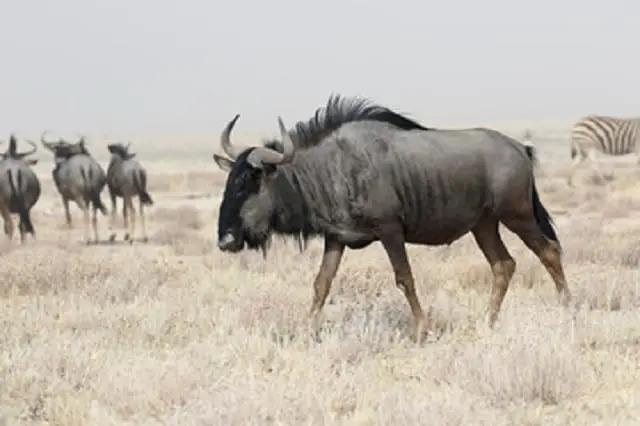Table of Contents
*This post may contain affiliate links. As an Amazon Associate we earn from qualifying purchases.
The wildebeest, otherwise known as the gnu is a member of the antelope family, which also includes such animals as sheep, goats, and cattle. The name “wildebeest” is from the Afrikaner’s language meaning wild beast. Native Africans used the name “gnu,” and the animal is well known by either name. Additionally, they’ve been referred to as the “fool of the veld” or “poor man’s buffalo.”
Wildebeest are strong. Although the average lifespan of a wildebeest is around 20 years if conditions are right. They don’t become ill or injured, and they’re not hunted. And they can live as long as 40 years. When they’re being chased across the tundra, they can cover ground at a remarkable 50 miles per hour.
Are There Different Types?
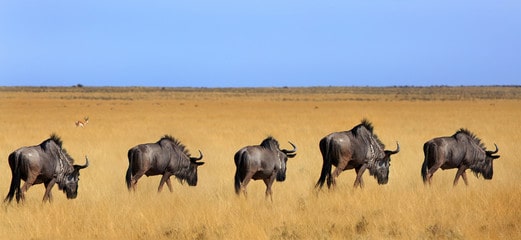
Unlike their cattle cousins, who have over 800 breeds worldwide, there only two types of wildebeest. The blue, or brindled gnu, and the black, or white-tailed gnu. These two are readily recognized by their appearance, making it easy to tell the difference.
Blue Wildebeest
The blue wildebeest is heavier, weighing in at around 550 pounds. Standing at five feet high, and measuring up to eight feet from nose to tail. It has a large, bison-like head with short horns that point out to the sides and curve upward. They also feature some subtle, zebra-like black stripes on the chest and shoulder portion of their otherwise brown bodies. They have a white beard, but their manes and tails are black. And they have a rounded rump with a smooth and a largely rounded hump at the shoulder.
Black Wildebeest
The black wildebeest, on the other hand, has a smaller, cow-like head and long, bent horns. Their beard is much shorter and black in contrast to their white tail. Their mane combines both colors; white at the base and tipped with black at the ends. The black wildebeest’s mane stands erect and is more brush-like than the blue. The black wildebeest has larger horns, which are oriented more forward with an upturned tip. The body is a solid dark brownish-black in color, and it has more of a swayback appearance with angular hips and shoulders. They weigh in at around 400 pounds and stand around four feet tall. Both species have smaller hindquarters in comparison with their massive chest and shoulders.
Where Do They Live?
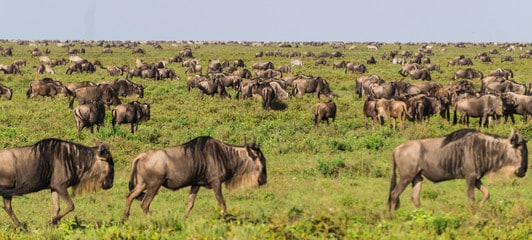
As you might have guessed, the wildebeest reside in Africa. With the greatest population in the Serengeti-Mara area of Tanzania and Kenya. The blue wildebeest, or brindled gnu, gather in herds of more than a thousand animals and travel between watering holes. This is a huge area covering parts or all of Kenya, Botswana, Mozambique, Tanzania, Zambia, Swaziland, South Africa, and Angola. At one time their habitat included Malawi and Namibia as well, but they’re no longer found there.
The blue wildebeest is the most plentiful big game species. Between migration periods they keep to a modified herd pattern. Females and young forming groups of ten or so, or they may join with larger groups to form herds. The males, or bachelors as they are called, tend to form herds of their own. They’re non-territorial until the rutting season comes.
East Africa
The blue wildebeest population in East Africa has the largest mammal migration pattern in the world. Covering close to 1000 miles during a season. These migrations generally coincide with the annual rainy season followed by the abundant growth of new grass. These migrating herds are made up of both male and female gnu.
Maasai Mara
The blue wildebeest also has a sedentary, or nomadic segment to its population in the Maasai Mara game reserve. A sitting target for predators. This could partially explain why their population was reduced from nearly 120,000 individuals in the late 1970’s to a mere 22,000 as of 1997. Periods of drought, combined with competing with local cattle for the grassy grazing lands, have also taken a toll on their numbers.
Black wildebeest don’t migrate in the same way. These animals tend to stay within line of sight – a range of around a third of a mile. The herds are made up of females and their young and may cover around 250 acres of land. Bulls tend to keep their distance and wander within a 30-foot to 5,200-foot range of the herd depending on feeding conditions. Non-territorial bachelor males will wander with seemingly no pattern or reason.
What Do Gnus Eat?
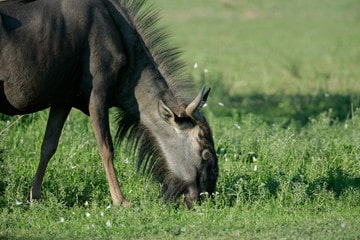
Wildebeest are herbivorous, eating only grassy plants that grow on the plains where they graze. It will also eat leaves and the tender shoots of various plants. They prefer those with a higher phosphorus content as well as those that are high in nitrogen. And they need to eat around five pounds of vegetation a day to survive and maintain strength. With herds numbering in the thousands, this can strip an area of plant life in no time.
How Many Young Do Gnus Have?
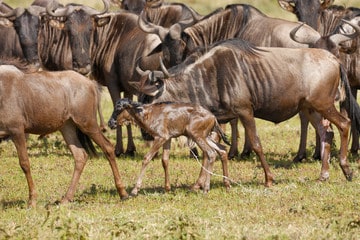
Gnus generally mate over a period of around 23 days – when they are well fed and strong following the rainy season. The gestational period of a wildebeest is 257 days or about eight and a half months. Most calves in the herd are born within a three-week-window. They move to the center of the herd to give birth while other animals keep watch.
Wildebeest calves weigh in at around 45 pounds at birth. They’re nursed by their mothers and can also begin eating grasses at around ten days old. They can stand and walk within just minutes of being born but must stay near their mothers to be safe from predators. The calves who survive are ready to mate beginning at sixteen months. And do so until they reach around six and a half years of age. They will generally give birth to one calf a year.
Who Are Their Predators?
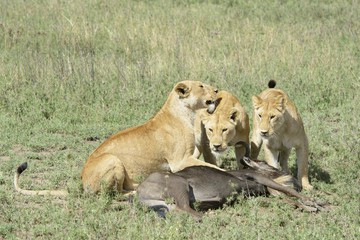
Wildebeest have an intimidating appearance. It can run at high speeds and are very muscular and strong, so its no surprise they can inflict damage on even the most vicious of attackers. And vicious attackers they have aplenty including hyenas, cheetahs, lions, and hunting dogs. These intimidating predators don’t think twice about picking off an animal from the edge of a herd. For this reason, wildebeest have developed the system of rotating guard duty. Some animals stand watch while others sleep.
Primary Defense
The primary defense of the wildebeest is to tighten the herd. When predators detected with females and young toward the inside. They then run as a group. As mentioned earlier, the herd, running on adrenalin can clock speeds upwards of 50 miles per hour when fleeing a predator. If the predator is a hyena, they have a good chance of quickly outrunning it. A lion can run right alongside the wildebeest herd. And unfortunately for the herd, cheetahs pass them up in no time, so cheetahs have a good chance of taking down an animal.
Other Predators
Crocodiles, which inhabit the watering holes and rivers, are also eager for a meal of fresh wildebeest. But because of the scarcity of fresh water, wildebeests are determined to take the herd in for a drink. Because of the other predators, the crocodiles, and frequent drownings. Vultures have learned to follow the wildebeest herds, and use them as a primary food source.
Farmers have also killed off a lot of gnus due to their encroachment onto, and destruction of crops and farmland. They’ve also erected fences to stop gnus from going into wetlands during periods of drought.
Do Wildebeest Interact With Other Animals?
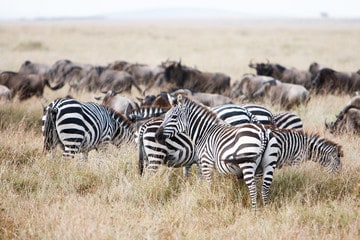
Not all animals the wildebeest encounters are a threat. In fact, they cohabitate quite well with zebras and giraffes, which find greater safety being numbered with the wildebeest herds. In return, the wildebeest hears the warning signals from these other species, and it helps keep them safe. Having a 15- to 20-foot lookout tower in the form of a giraffe can be a real advantage. They also listen for warnings from baboons that live in trees nearby.
Does the Wildebeest Benefit Its Habitat?
Here’s A Video on Blue Wildebeest…Life/Habitat
In addition to providing a tasty meal for its predators. The wildebeest does offer some ecological benefits to its area of habitat. Their depletion of grasses and leaves is offset by the running of the herd. Also, the tons of dung that are left on the ground provide a home for the dung beetle to lay its eggs. The beetle rolls the dung into balls, lays its eggs and then buries the dung ball in the soil. This provides fertilizer and nutrients for the soil to grow new grasses.
Gnus have learned behaviors and instincts that both protect them and help them find food. They have a symbiotic relationship with many other animals and are fiercely protective of their own. Whether you call them a wildebeest or a gnu, these tough and rugged animals are a symbol of triumph over the harsh elements of the African plains.

